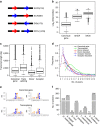The evolutionary landscape of intergenic trans-splicing events in insects
- PMID: 26521696
- PMCID: PMC4667647
- DOI: 10.1038/ncomms9734
The evolutionary landscape of intergenic trans-splicing events in insects
Abstract
To explore the landscape of intergenic trans-splicing events and characterize their functions and evolutionary dynamics, we conduct a mega-data study of a phylogeny containing eight species across five orders of class Insecta, a model system spanning 400 million years of evolution. A total of 1,627 trans-splicing events involving 2,199 genes are identified, accounting for 1.58% of the total genes. Homology analysis reveals that mod(mdg4)-like trans-splicing is the only conserved event that is consistently observed in multiple species across two orders, which represents a unique case of functional diversification involving trans-splicing. Thus, evolutionarily its potential for generating proteins with novel function is not broadly utilized by insects. Furthermore, 146 non-mod trans-spliced transcripts are found to resemble canonical genes from different species. Trans-splicing preserving the function of 'breakup' genes may serve as a general mechanism for relaxing the constraints on gene structure, with profound implications for the evolution of genes and genomes.
Figures





Similar articles
-
Trans-splicing of the mod(mdg4) complex locus is conserved between the distantly related species Drosophila melanogaster and D. virilis.Genetics. 2005 Feb;169(2):723-36. doi: 10.1534/genetics.103.020842. Epub 2004 Nov 1. Genetics. 2005. PMID: 15520256 Free PMC article.
-
RNA editing and alternative splicing of the insect nAChR subunit alpha6 transcript: evolutionary conservation, divergence and regulation.BMC Evol Biol. 2007 Jun 27;7:98. doi: 10.1186/1471-2148-7-98. BMC Evol Biol. 2007. PMID: 17597521 Free PMC article.
-
Spliced leader RNA-mediated trans-splicing in phylum Rotifera.Mol Biol Evol. 2005 Jun;22(6):1482-9. doi: 10.1093/molbev/msi139. Epub 2005 Mar 23. Mol Biol Evol. 2005. PMID: 15788744
-
The modifier of mdg4 locus in Drosophila: functional complexity is resolved by trans splicing.Genetica. 2003 Mar;117(2-3):165-77. doi: 10.1023/a:1022983810016. Genetica. 2003. PMID: 12723696 Review.
-
The evolution of spliced leader trans-splicing in nematodes.Biochem Soc Trans. 2010 Aug;38(4):1125-30. doi: 10.1042/BST0381125. Biochem Soc Trans. 2010. PMID: 20659016 Review.
Cited by
-
Integrative transcriptome sequencing reveals extensive alternative trans-splicing and cis-backsplicing in human cells.Nucleic Acids Res. 2018 Apr 20;46(7):3671-3691. doi: 10.1093/nar/gky032. Nucleic Acids Res. 2018. PMID: 29385530 Free PMC article.
-
A survey on cellular RNA editing activity in response to Candida albicans infections.BMC Genomics. 2018 Jan 19;19(Suppl 1):43. doi: 10.1186/s12864-017-4374-2. BMC Genomics. 2018. PMID: 29363428 Free PMC article.
-
Identified trans-splicing of YELLOW-FRUITED TOMATO 2 encoding the PHYTOENE SYNTHASE 1 protein alters fruit color by map-based cloning, functional complementation and RACE.Plant Mol Biol. 2019 Aug;100(6):647-658. doi: 10.1007/s11103-019-00886-y. Epub 2019 Jun 1. Plant Mol Biol. 2019. PMID: 31154655
-
An Investigation of the Conservatism of Sequences Defining trans-Splicing in the mod(mdg4) Locus across Drosophila and Silkworm Species.Dokl Biochem Biophys. 2025 Feb;520(1):144-147. doi: 10.1134/S1607672924601021. Epub 2025 Jan 31. Dokl Biochem Biophys. 2025. PMID: 39899251
-
Evolutionary Insights into RNA trans-Splicing in Vertebrates.Genome Biol Evol. 2016 Mar 10;8(3):562-77. doi: 10.1093/gbe/evw025. Genome Biol Evol. 2016. PMID: 26966239 Free PMC article. Review.
References
-
- Maniatis T. & Tasic B. Alternative pre-mRNA splicing and proteome expansion in metazoans. Nature 418, 236–243 (2002). - PubMed
-
- Pan Q., Shai O., Lee L. J., Frey B. J. & Blencowe B. J. Deep surveying of alternative splicing complexity in the human transcriptome by high-throughput sequencing. Nat. Genet. 40, 1413–1415 (2008). - PubMed
Publication types
MeSH terms
Substances
LinkOut - more resources
Full Text Sources
Other Literature Sources

